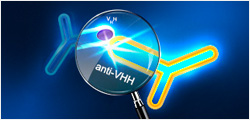| Species |
Human |
| Protein Construction |
CXCL9 (Thr23-Thr125)
Accession # Q07325 |
|
| Purity |
> 97% as analyzed by SDS-PAGE
> 97% as analyzed by HPLC |
| Endotoxin Level |
< 1 EU/μg of protein by LAL method |
| Biological Activity |
Fully biologically active when compared to standard. The biological activity determined by a chemotaxis bioassay using human peripheral blood T-lymphocytes is in a concentration range of 10.0-100.0 ng/ml. |
| Expression System |
E. coli |
| Theoretical Molecular Weight |
11.7 kDa |
| Formulation |
Lyophilized from a 0.2 μm filtered solution in 20 mM PB, pH 7.4, 50 mM NaCl. |
| Reconstitution |
It is recommended that this vial be briefly centrifuged prior to opening to bring the contents to the bottom. Reconstitute the lyophilized powder in sterile distilled water or aqueous buffer containing 0.1 % BSA to a concentration of 0.1-1.0 mg/ml. |
| Storage & Stability |
Upon receiving, this product remains stable for up to 6 months at -70°C or -20°C. Upon reconstitution, the product should be stable for up to 1 week at 4°C or up to 3 months at -20°C. Avoid repeated freeze-thaw cycles. |
| Target Background |
Chemokine (C-X-C motif) ligand 9 (CXCL9), also known as monokine induced by interferon gamma (MIG), is a small cytokine belonging to the CXC chemokine family. The CXCL9 gene is induced in macrophages and in primary glial cells of the central nervous system specifically in response to IFNγ. CXCL9 has been shown to be a chemoattractant for activated T-lymphocytes and TIL but not for neutrophils or monocytes. The human CXCL9 cDNA encodes a 125 amino acid residue precursor protein with a 22 amino acid residue signal peptide that is cleaved to yield a 103 amino acid residue mature protein. CXCL9 has an extended carboxy-terminus containing greater than 50% basic amino acid residues and is larger than most other chemokines. A chemokine receptor (CXCR3) specific for CXCL9 and IP-10 has recently been cloned and shown to be highly expressed in IL-2-activated T-lymphocytes. |
| Synonyms |
CXCL-9; CMK; Humig; MIG; SCYB9; crg-10; C-X-C motif chemokine ligand 9; Small inducible cytokine B9; Gamma interferon-induced monokine; monokine induced by gamma-interferon |
����� For laboratory research use only. Direct human use, including taking orally and injection and clinical use are forbidden. �������

































